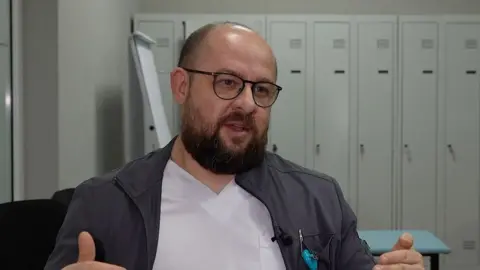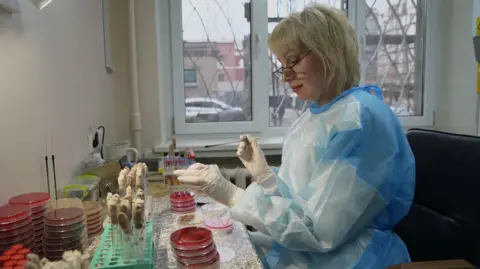 BBC
BBCWhen Private Oleksandr Bezverkhny was evacuated to Feofania Hospital in Kiev, few believed he would live. The 27-year-old was seriously injured in the abdomen and his buttocks were torn by shrapnel. His legs were amputated.
Then doctors discovered that his infections were resistant to commonly used antibiotics, and the already daunting task of saving his life became almost hopeless.
Antimicrobial resistance (AMR) occurs when bacteria evolve and learn how to defend themselves against antibiotics and other medications, rendering them ineffective.
Ukraine is not the only country affected by this problem: around 1.4 million people died globally from antimicrobial resistant infections in 2021, and in the United Kingdom there were 66,730 serious antibiotic-resistant infections in 2023. However, the war appears to have led to Accelerate the spread of the disease. Multi-resistant pathogens in Ukraine.
Clinics treating war injuries have recorded a sharp increase in cases of antimicrobial resistance. More than 80% of all patients admitted to Feofaniya Hospital suffer from infections caused by antibiotic-resistant microbes, according to Deputy Chief Medical Officer Dr. Andrej Strukan.
Ironically, antimicrobial-resistant infections often arise from medical facilities.
Medical staff try to follow strict hygiene protocols and use protective equipment to reduce the spread of this infection, but facilities can be crowded with people injured in war.
Dr. Volodymyr Dubina, head of the intensive care unit at Mechnikov Hospital, said that since the beginning of the Russian invasion, his unit alone has increased the number of beds from 16 to 50. At the same time, with many staff fleeing the war or joining the army themselves, staffing has reached levels Low.
Dr. Strokan explained that these conditions can affect the spread of antimicrobial resistant bacteria. “In the surgical departments, there is one nurse who takes care of 15 to 20 patients,” he said. “She physically cannot clean her hands with the amount and frequency required so as not to spread the infection.”

The nature of this war also means that patients are exposed to far more strains of infection than they would be in peacetime. When a soldier is medically evacuated, they often pass through multiple facilities, each with its own strains of antimicrobial resistance. While medical professionals say this is inevitable due to the scale of the war, it only exacerbates the spread of antimicrobial resistance infections.
This was the case for Dr PT Bezverkhny, who was treated in three different facilities before arriving at the hospital in Kiev. Since his infections could not be treated with usual medications, his condition deteriorated and he contracted sepsis five times.
This situation differs from other recent conflicts, for example the Afghanistan war, where Western soldiers are installed on site and then flown to a European clinic rather than passing through multiple different local facilities.

This would not be possible in Ukraine because the influx of patients has not occurred since World War II, according to Dr. Dubina, whose hospital in Dnipro is located next to front-line areas. Once his patients are stable enough, they are moved to another clinic – if it has space – to free up capacity.
“In terms of microbiological control, that means it spreads [bacteria] additional. But if this is not done, we will not be able to work. Then it’s a disaster.”
With so many wounded, Ukrainian hospitals usually cannot afford to isolate infected patients – meaning that dangerous, multi-resistant bacteria spread unchecked.
The problem is that the infections they cause must be treated with special antibiotics from the “precautionary” list. But the more often doctors prescribe these antibiotics, the faster the bacteria adapt, making those antibiotics ineffective as well.
“We have to balance our scales,” explains Dr. Strokan. “On the one hand, we must save the patient. On the other hand – we must not produce new microorganisms with antimicrobial resistance.”

In the case of PT Bezverkhny, doctors had to use expensive antibiotics, which volunteers obtained from abroad. After a year in the hospital and more than 100 surgeries, his condition was no longer life-threatening.
Doctors were able to save his life. But as resistance to pathogens increases, the struggle to save others becomes more difficult.
https://ichef.bbci.co.uk/news/1024/branded_news/179b/live/5f08e610-d422-11ef-87df-d575b9a434a4.jpg

